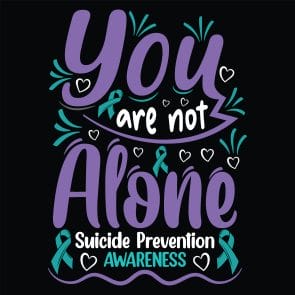Suicide is a prevalent problem that affects individuals of all ages, genders, economic levels, and ethnic backgrounds. National Suicide Prevention Week is one of several initiatives that use education and awareness to reverse rising rates of suicide in the United States.
When is Suicide Prevention Week?
National Suicide Prevention Week, is one of three coordinated observances that are sponsored by the American Foundation for Suicide Prevention (AFSP).
Here’s the Suicide Prevention Awareness schedule for 2023:
- National Suicide Prevention Month in 2023 is the month of September
- National Suicide Prevention Week in 2023 is from September 10th to the 16th (Sunday to Saturday)
- World and National Suicide Prevention Day in 2023 is on September 10th (Sunday)
World Suicide Prevention Day is a global event that is co-sponsored by the World Health Organization (WHO) and the International Association for Suicide Prevention (IASP).
What is National Suicide Prevention Week?

National Suicide Prevention Week is part of an annual awareness campaign that is typically held the first full week after Labor Day. Each year, the three observances that we listed in the previous section are united by a theme that focuses on one aspect of the effort to eliminate suicide throughout the United States.
This year, the theme for National Suicide Prevention Week, Day, and Month is Talk Away the Dark. This theme highlights the fact that being willing to discuss this important topic can reduce stigma, eliminate shame, and serve as a beacon of light and hope for people who are struggling.
In addition to supporting people who are currently experiencing suicidal thoughts, Talk Away the Dark also focuses on the following objectives:
- Educating people about the factors that can increase a person’s risk of suicide
- Training the public to recognize the signs that someone may be considering suicide
- Promoting protective factors that can decrease the likelihood that someone will attempt to end their own life
As is tradition, many of the graphics, social media posts, and other visual elements that are associated with this year’s theme will be accompanied by a ribbon in the AFSP’s National Suicide Prevention Week colors of teal and purple. The IASP’s global events typically feature a yellow and orange ribbon.
Ideas to Help Bring More Awareness for Suicide Prevention Week 2023
Here are just a few of the many ways you can promote suicide prevention awareness during September and throughout the rest of the year.
- Organize or participate in a National Suicide Prevention Week event in your community.
- Share suicide prevention information on your social media accounts.
- Invite suicide prevention experts to speak at your school or workplace.
- Educate yourself about suicide prevention tips and strategies.
Above all else, don’t be afraid to talk to your friends and family members about suicide. Contrary to an unfortunately persistent myth, talking about this important topic won’t give someone the idea to end their own life. If you believe that someone you care about is in crisis, being willing to have this conversation can demonstrate to them that they are not alone, and that help is available.
Why is Suicide Prevention Week So Important?
It is virtually impossible to overstate the importance of National Suicide Prevention Week and related efforts. To underscore the acuity of this growing problem, the U.S. Centers for Disease Control and Prevention (CDC) has reported that the nation’s annual suicide rate increased by 35% between 2000–2021.
The CDC has also provided the following statistics about suicide in the United States:
- A provisional report indicates that 49,449 people died by suicide in the U.S. in 2022. This represents a 2.6% increase from the number of suicide deaths in 2021.
- Experts estimate that more than 12 million Americans seriously considered suicide in the previous 12 months, and about 3.5 million of these individuals developed a plan to end their life.
- The suicide rate among men is more than four times larger than among women.
- More than 46% of all suicide deaths in the U.S. involve adults aged 35-64.
- About 15% of suicide deaths in the U.S. involve individuals aged 10-24.
- Three states – Alaska, Montana, and Wyoming – have an annual suicide rate above 30 deaths per 100,000 residents.
- Only four states have an annual suicide rate below 10 deaths per 100,000 residents. These states include, Maryland, Massachusetts, New York, and New Jersey.
Suicide Prevention Resources and Hotlines
If you have been experiencing thoughts of suicide, or if you believe that someone you care about has been thinking about ending their life, please know that help is available.
If you are in the United States, you can contact the 988 Suicide & Crisis Lifeline 24 hours a day, seven days a week, by calling 988 or visiting https://988lifeline.org/. This service is staffed by trained professionals who can assess your needs and connect you with appropriate resources near you.
Features of the Lifeline’s website include a Spanish version and accessibility information for individuals who are deaf or hard of hearing.
The following organizations also offer valuable suicide prevention resources:
- American Foundation for Suicide Prevention
- The Jason Foundation
- National Institute of Mental Health
- The Trevor Project
- U.S. Centers for Disease Control and Prevention
Contact Montare Behavioral Health About Our Los Angeles Mental Health Treatment Center
Suicidal ideation is sometimes (but not always) a symptom of a mental health disorder. People who have depression, bipolar disorder, posttraumatic stress disorder (PTSD), and other concerns may be at increased risk for attempting to end their lives.
If you or someone in your life has been experiencing suicidal thoughts due to a mental or behavioral health challenge, Montare Behavioral Health is here to help. We offer personalized care and compassionate support at several convenient locations throughout southern California. To learn more or to schedule a free assessment for yourself or your loved one, please visit our Contact Us page or call us today.
























